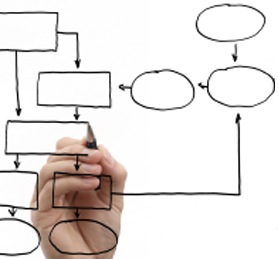Indice
Business Processes Modeling
MPB 2025/26 (295AA / 372AA, 6 cfu)
Lecturers: Roberto Bruni, Andrea Vandin
Contact: web Bruni - web Vandin
Office hours: Thursday 15:00-18:00
Objectives
The course aims to reconcile abstraction techniques and high-level diagrammatic notations together with modular and structural approaches. The objective is to show the impact of the analysis and verification properties of business processes on the choice of the best suited specification and modelling languages. At the end of the course, the students will gain some familiarity with business process terminology, with different models and languages for the representation of business processes, with different kinds of logical properties that such models can satisfy and with different analysis and verification techniques. The students will also experiment with some tools for the design, synthesis and analysis of business processes.
Course Overview
Business process management. Evolution of Enterprise Systems Architectures. Conceptual models and abstraction mechanisms. Petri nets: invariants, S-systems, T-systems, Free-choice systems and their properties. Workflow nets and workflow modules. Workflow patterns. Event-driven Process Chains (EPC). Business Process Modelling Notation (BPMN), Process performance analysis. Process simulation. Process Mining.
Textbook(s)
- Business Process Management: Concepts, Languages, Architectures (book on BPM, main reference)
- Diagnosing workflow processes using Woflan (article on Formal Analysis of Workflows, recommended reading)
- Workflow Management: Models, Methods, and Systems (book on Workflow Management, optional reading)
- Free Choice Nets (book on Petri nets, optional reading)
- Fundamentals of Business Process Management (book on BPMN, optional reading)
- Process Mining (book on Process Mining, optional reading)
- Further bibliography and lecture notes will be indicated during the course.
Quick reference(s)
- PNML (Petri Nets Markup Language): XML-based standard for Petri nets
- BPMN: Quick guide
- XES (eXtensible Event Stream): XML-based standard for event logs
- RePROSitory: (Repository of open PROcess models and logS)
Tool(s)
- Woped: Workflow Petri Net Designer
- ProM: Process Mining Framework
- yEd: Graph Editor
- ARIS Express: Flowchart Editor
- Yaoqiang BPMN Editor: BPMN Editor
- BPMN.io: BPMN Editor
- Camunda Modeler: BPMN Editor
- Bizagi Process Modeler: BPMN editor (Windows only)
- Visual Paradigm supports University of Pisa with UML tools and ERD tools under the VP Academic Training Partner Program
- Disco: Business Process Mining Tool
- YAWL: Yet Another Workflow Language platform
- BIMP: Business Process Simulator
Exam
The evaluation will be based on a group project and an oral exam.
Registration to the exam is mandatory.
The student must demonstrate the ability to put into practice and to execute, with critical awareness, the activities illustrated or carried out under the guidance of the teacher during the course.
Project FAQ
- What are the prerequisites for having a project assigned? There are no prerequisites, but the teacher will assume that you have already studied all the material of the course (if this is not the case, then it is very likely that you won't be able to deliver the project in time).
- How many people can work together on the same project? Projects are assigned to individuals or to groups of two people. Exceptionally, groups of three people can be allowed, but a solid motivation is needed.
- When is it possible to request the project description? After the end of the lectures, any (working) day of the year.
- How do we request a project description? By sending an email to the teacher (possibly including the text
BPM project requestin the object, and mandatorily including full names, student ids and email addresses of all students in the group). The teacher will then reply (in a few days) with the project description. - Which graphical notation should we use in the modelling? You decide: typically EPC is fine for representing orchestrations, BPMN for both orchestration and choreography (collaboration diagrams).
- Which tools should we use to design EPC diagrams or BPMN diagrams? Some tools are suggested in this page, but you are free to evaluate any other tool and then choose the one that you prefer. For example some cross-platform tools are: yEd is versatile, user-friendly, has powerful automatic layout features but cannot export diagrams in .epml and .bpmn formats; Visual Paradigm online is also versatile and can export diagrams in several formats; Camunda modeler offers the essential features for drawing nice BPMN diagrams. Please, briefly motivate your choice in the report.
- Which tools should we use for soundness analysis of workflow nets? My suggestion is to try to use Woped first, and then Woflan as a backup (as a Microsoft Windows application or as a ProM plugin, running on all platforms) if Woped is not responding fast enough or you like to collect information about error sequences to repair your model. If you find out other tools that can be used to the purpose, feel free to use them as well.
- How do we convert graphical diagrams into workflow nets? I am afraid the short answer is: manually. ProM offers some plugins but the outcome is very different and typically more complex than the one presented in the course. If you find other tools that can help you to speed up the conversion, feel free to use them.
- When is the deadline for submitting the project? The deadline will be sent by the teacher together with the project description: typically it leaves three weeks to complete the project (but vacation periods are taken into account).
- What does it happen if we miss the deadline? You will have to request a new project, unless you inform the teacher a few days before the deadline, asking for a short extension of the deadline and explaining the reasons for the delay.
- What does it happen if a person leaves the group? You must notify immediately the teacher and choose if you prefer to complete the work individually or to request another project later on.
- How do we deliver the project? You must send the teacher a short project report in .pdf format together with the source files of all diagrams and nets you designed. Optionally, you can submit the soundness analysis checklist (available on the Microsoft Teams channel) for any of your model.
- When do we discuss the project? Preferably, at the first exam session that follows the delivery of the project.
- Is it necessary to have already delivered the project in order to register for the exam? No it is not. But of course the project must be delivered in time for being discussed at the actual oral exam.
Exam FAQ
- How do we register for the exam? As usual, you must enter your choice on the ESAMI portal.
- What are the dates of the exam? THE DATES ADVERTISED IN THE ESAMI PORTAL ARE NOT NECESSARILY THOSE OF THE ACTUAL EXAM. After you register for the exam, on the basis of the projects received and any other constraint communicated by each student, the teacher will post a tentative schedule on this web page and will inform you by email or on Teams.
- How is the exam organized? The exam is oral and it is organised in two parts: the first part will focus on the project discussion, the second part will involve all topics covered by the course.
- How is the project discussion organized? ALL GROUP MEMBERS MUST BE PRESENT TO THE PROJECT DISCUSSION. All group members must demonstrate they have participated to all the activites of the project. A negative evaluation of the project may require to rework some parts, submit a revised report and schedule a new exam (possibly at the next exam session). A positive evaluation of the project allows each group member to access the second part of the exam.
- How is the second part of the exam organized? DIFFERENT GROUP MEMBERS CAN ASK TO SCHEDULE THE SECOND PART OF THE EXAM ON DIFFERENT DAYS. Questions may involve (but are not limited to): most relevant concepts, definitions, terminology and techniques; their intuitive meaning and formalization; proof sketches of formal statements; small-sized exercises. Arguments marked as optional in the lectures table below can be discussed upon student request.
- Is it possible to pass the first part of the exam and fail the second? Let's hope it won't happen, but yes, it is possible, in which case the student will need to register for one of the next exam sessions. Depending on each single case, a new project may also be assigned.
Announcements
- As the course starts:
Each student must subscribe the Microsoft Teams channel of the course.
Then, please spend a few minutes to fill the form Background Check that will be helpful to tune the pace and content of the course.
Lectures (first half)
Microsoft Teams: Additional material is available on Teams.
| N | Date | Time | Room | Lecture notes | Topics | Links | |
|---|---|---|---|---|---|---|---|
| 1 | 17/09 | 14:00-16:00 | L1 | Lecture 1 | Course introduction: course objectives, textbooks, BPM aim and motivation, models and abstraction | ||
| 2 | 19/09 | 11:00-13:00 | L1 | Lecture 2 | Introduction to Business Processes: Taylorism, work units, processes, terminology, organizational structures, process orientation and reengineering, visual notations | ||
| 3 | 24/09 | 14:00-16:00 | L1 | Lecture 3 | Exercises: Alice-Bob car selling scenario Examples: Orchestration diagrams, collaboration diagrams, choreography diagrams | ||
| 4 | 26/09 | 11:00-13:00 | L1 | Lecture V1 | Introduction to Process Mining with hands-on tutorial on Fluxicon Disco (Prof. Vandin) | ||
| 5 | 01/10 | 14:00-16:00 | L1 | Lecture 4 | Informal intro to Workflow nets: Petri nets basics, workflow net definition, WoPeD tool, syntax sugar, subprocesses, control flow aspects, triggers, modelling with workflow nets | Woped | |
| - | 03/10 | 11:00-13:00 | L1 | Canceled | General strike | ||
| 6 | 08/10 | 14:00-16:00 | L1 | Lecture 5 | Process mining: event logs, discovery, conformance, enhancement, perspectives, play-in, play-out, replay, overfitting, underfitting, footprint matrix, alpha-algorithm | ||
| - | 10/10 | 11:00-13:00 | L1 | Canceled | Orientation activities | ||
| 7 | 15/10 | 14:00-16:00 | Teams | Lecture V2 | The Python library for Process Mining: PM4PY. Overview to event logs analysis, process discovery, and conformance checking. (a practitioner perspective) (Prof. Vandin) | ||
| 8 | 17/10 | 11:00-13:00 | C1 | Lecture V3 | Formal introduction to dependency graphs and to the heuristic miner. Footprint-based conformance checking. (Prof. Vandin) | ||
| 9 | 22/10 | 14:00-16:00 | C1 | Lecture 6 | Orchestration, choreography, collaboration diagrams | ||
| 10 | 24/10 | 11:00-13:00 | C1 | Lecture 7a | EPC and BPMN guidelines | ||
| 11 | 29/10 | 14:00-16:00 | C1 | Lecture 7b | BPMN key features | ||
| 12 | 31/10 | 11:00-13:00 | C1 | Lecture 8 | Petri nets theory and properties |
Lectures (second half)
Microsoft Teams: Additional material is available on Teams.
| N | Date | Time | Room | Lecture notes | Topics | Links |
|---|---|---|---|---|---|---|
| 13 | … | … | L1 | |||
| 14 | … | … | L1 |










